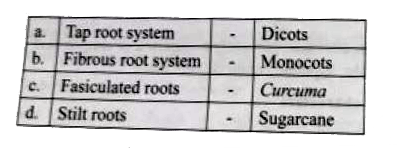Mark the mismatched pair,
Cellulose: Unbranched polymer with , 1-4 glycosidic linkage
Cellophane: Cellulose xanthate
Cellophane: Exopeptidase, acts as a co-factor
Aminopeptidase: Exopeptidase, cleaves the peptide bond at N- terminal end
The correct Answer is:C
To identify the mismatched pair from the given options, we will analyze each option step by step.
Step 1: Analyze the first pair - Cellulose
- Statement: Cellulose is an unbranched polymer with beta-1,4 glycosidic linkages.
- Analysis: This statement is true. Cellulose is indeed an unbranched polysaccharide made up of β-1,4-glycosidic linkages between glucose units.
Step 2: Analyze the second pair - Cellophane and Cellulose Xanthate
- Statement: Cellophane is chemically similar to cellulose xanthate.
- Analysis: This statement is also true. Cellophane is derived from cellulose and is chemically similar to cellulose xanthate, which is a derivative of cellulose.
Step 3: Analyze the third pair - Cellophane and Exopeptidase
- Statement: Cellophane is an exopeptidase and Mg²⁺ acts as a cofactor.
- Analysis: This statement is incorrect. Cellophane is not an enzyme; it is a regenerated form of cellulose used in packaging. Exopeptidases are enzymes that break down peptides into amino acids, and while Mg²⁺ can act as a cofactor for some enzymes, it does not apply to cellophane.
Step 4: Analyze the fourth pair - Aminopeptidase
- Statement: Aminopeptidase is an exopeptidase that cleaves peptide bonds from the N-terminal.
- Analysis: This statement is true. Aminopeptidase is indeed an exopeptidase that removes amino acids from the N-terminal end of peptides.
Conclusion
After analyzing all the pairs, we find that the mismatched pair is:
- Cellophane is an exopeptidase (This is incorrect).
Thus, the answer is option C.
---
- Statement: Cellulose is an unbranched polymer with beta-1,4 glycosidic linkages.
- Analysis: This statement is true. Cellulose is indeed an unbranched polysaccharide made up of β-1,4-glycosidic linkages between glucose units.
- Statement: Cellophane is chemically similar to cellulose xanthate.
- Analysis: This statement is also true. Cellophane is derived from cellulose and is chemically similar to cellulose xanthate, which is a derivative of cellulose.
- Statement: Cellophane is an exopeptidase and Mg²⁺ acts as a cofactor.
- Analysis: This statement is incorrect. Cellophane is not an enzyme; it is a regenerated form of cellulose used in packaging. Exopeptidases are enzymes that break down peptides into amino acids, and while Mg²⁺ can act as a cofactor for some enzymes, it does not apply to cellophane.
- Statement: Aminopeptidase is an exopeptidase that cleaves peptide bonds from the N-terminal.
- Analysis: This statement is true. Aminopeptidase is indeed an exopeptidase that removes amino acids from the N-terminal end of peptides.
After analyzing all the pairs, we find that the mismatched pair is:
- Cellophane is an exopeptidase (This is incorrect).
Similar Questions
Knowledge Check
- Question 1 - Select One
Select the mismatched pair
AAmphibians of plant kingdom-BryophytesBFirst terrestrial plants to possess vascular tissues-GymnospermsCWater required for fertilisation-PteridophytesDSeeds enclosed in fruits- Angiosperms - Question 2 - Select One
Find out the mismatched pair
ALyonisation - Liane Russell and mary LyonBY-chromosome - Stevens and WilsonCX-body - HenkingDShortgun sequencing - Jeffreys - Question 3 - Select One
Find out the mismatched pair
AC4-plants - Kranz anatomyBPrimary CO2 fixation product of C4-plants - OAACPrimary CO2acceptor of C3-plants - RuBPDC3 -plants - Maize


